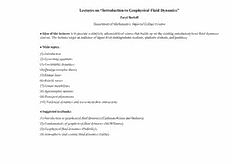
Lectures on Introduction to Geophysical Fluid Dynamics PDF
Preview Lectures on Introduction to Geophysical Fluid Dynamics
Lectures on “Introduction to Geophysical Fluid Dynamics” PavelBerloff DepartmentofMathematics,ImperialCollegeLondon Idea of the lectures is to provide a relatively advanced-level course that builds up on the existing introductory-level fluid dynamics • courses. Thelectures target an audienceofupper-levelundergraduatestudents,graduatestudents,and postdocs. Maintopics: • (1)Introduction (2)Governingequations (3)Geostrophicdynamics (4)Quasigeostrophictheory (5)Ekman layer (6)Rossbywaves (7)Linear instabilities (8)Ageostrophicmotions (9)Transportphenomena (10)Nonlineardynamicsandwave-mean flowinteractions Suggested textbooks: • (1)Introductiontogeophysicalfluiddynamics(Cushman-Roisinand Beckers); (2)Fundamentalsofgeophysicalfluiddynamics(McWilliams); (3)Geophysicalfluiddynamics(Pedlosky); (4)Atmosphericand oceanicfluiddynamics(Vallis). Motivations Main motivations for the recent rapid developmentof GeophysicalFluid Dynamics (GFD) includethe following • very important, challenging and multidisciplinary set of problems: — Earth system modelling, — Predictive understanding of climate variability (emerging new science!), — Forecast of various natural phenomena, — Natural hazards, environmental protection, natural resources, etc. What is GFD? Most of GFD is about dynamics of stratified and turbulent fluid on giant rotating sphere. • On smaller scales GFD is just classical fluid dynamics with geophysical applications. — Other planets and some astrophysical fluids (e.g., stars, galaxies) are also included in GFD. GFD is a mix of applied math and theoretical physics. • It is about mathematical representation and physical interpretation of geophysical fluid motions. MathematicsofGFDisheavilycomputational,even,relativetootherbranchesoffluiddynamics(e.g.,modelling • of the ocean circulation and atmospheric clouds are the largest computational problems in the history of science). — This is because lab experiments (i.e., analog simulations) can properly address only tiny fraction of interesting questions (e.g., small-scale waves, convection, microphysical processes). Theoretical advances are often GFD-based rather than experiment-based, because the real field measurements • are extremely complex, difficult, expensive and often impossible. An image of Earth from space: Earth’s atmosphere • and oceans are the main but not the only targets of GFD This is not an image of the Earth from space... ...but a visualized solution of the mathematical equations! Atmospheric cyclones and anticyclones constitute most of the midlatitude weather. • This cyclone is naturally visualized by clouds: Modelling clouds is the most difficult problem in atmospheric science. • Tropical cyclones (hurricanes and typhoons) are a coupled ocean-atmosphere phenomenon. • These are powerful storm systems characterized by low-pressure center, strong winds, heavy rain, and numerous thunderstorms. Hurricane Katrina is getting close to New Orleans: Ocean-atmosphere coupling: Ocean and atmosphere exchange momentum, heat, water, ra- • diation, aerosols, and greenhouse gases. Ocean-atmosphere interface is a very complex dual boundary layer: Ocean currents are characterized by numerous transient mesoscale eddies: Mesoscale eddies are dynamically similar to atmospheric cyclones and anticyclones, but • much smaller and more abundant; Modelling these eddies and their effects is very important and challenging. • Submesoscale eddies around an island: Submesoscale and smaller-scale • motions are geostrophically and hydrostatically unbalanced. Many GFD processes are influen- • ced by coasts and topography (e.g., coastal currents, upwellings, tidal mixing, lee waves). Turbulence operates on all scales down to millimeters, but on smaller scales effects of plane- • tary rotation and vertical stratification weaken and GFD turns into classical fluid dynamics. GFD deals with different waves operating on scales from meters to thousands of kilometers. • Problem of internal gravity wave breaking is very important and challenging. • Breaking surface gravity waves:
